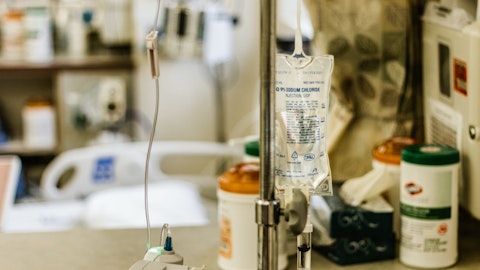Quanterix Corporation (NASDAQ:QTRX) Q3 2023 Earnings Call Transcript November 7, 2023
Operator: Good day and thank you for standing by. Welcome to the Quanterix Corporation Q3 2023 Earnings Call. At this time, all participants are in a listen-only mode. After the speakers’ presentation, there will be a question-and-answer session. [Operator Instructions] Please be advised that, today’s conference is being recorded. I would now like to hand the conference over to your first speaker today Ed Joyce. Please go ahead.
Ed Joyce: Thank you, Hope, and good morning. With me on today’s call is Masoud Toloue President and CEO of Quanterix and Vandana Sriram, Chief Financial Officer. Vandana joined us in August as Mike Doyle transitions into retirement in early 2024. Before we begin, I’d like to remind you of a few things. The call will be recorded and will be available on the Investor Resources section of our website. Today’s call will contain forward-looking statements, within the meaning of the US Private Securities Litigation Reform Act. These forward-looking statements are based on management’s beliefs and assumptions and on information available as of the date of the call. We may not actually achieve the plans, intentions, or expectations disclosed in our forward-looking statements.

Forward-looking statements involve known and unknown risks, uncertainties, assumptions, and other factors that may cause our actual results performance or achievements to be materially different from any future results performance or achievements expressed or implied by the forward-looking statements. The risks and uncertainties that we face are described in our most recent filings, with the Securities and Exchange Commission. To supplement the company’s financial statements presented on a GAAP basis, the company has provided certain non-GAAP financial measures. Management uses these non-GAAP measures to evaluate operating performance in a manner that allows for meaningful period-to-period comparison and analysis of trends in its business. The company believes that, such measures are important to comparing current results to the other period results and are useful in assessing the company’s operating performance.
The non-GAAP financial information presented here should be considered in conjunction with, and not as a substitute for, the financial information presented in accordance with GAAP. Investors are encouraged to review the reconciliation of these non-GAAP measures to their most directly comparable GAAP financial measures set forth in the appendix of the presentation posted to our website and in the earnings release issued today. With that, I’ll turn the call over to Masoud.
Masoud Toloue: Thank you, Ed. Good morning, everyone, and thank you for joining us on our third quarter call. We’re pleased to announce the six-quarter transformation plan we laid out last year is expected to be substantially complete by year end, with assays rolling off our new scalable production platform in January. Incremental improvements made throughout this year have been positively reflected in our financial results and continue to do so in the third quarter with year-over-year revenue up 18% to $31.3 million, non-GAAP gross margin improving 1,300 basis points to 48.6%, and disciplined cash use going from over $17 million for the corresponding prior year period to under $ 2 million this quarter. On the foundation of this new ops platform, we will continue to improve gross margins and take our research business from one that’s burning cash to one that’s generating it.
See also 11 Best Edge Computing Stocks to Buy Now and 20 Least Productive States in the US.
Q&A Session
Follow Quanterix Corp (NASDAQ:QTRX)
Follow Quanterix Corp (NASDAQ:QTRX)
Receive real-time insider trading and news alerts
We’ll deploy capital to first expand access to our platform and second, enable patient testing with new biomarker solutions we’ve recently developed. Simoa continues to be the leader in measuring proteins at the lowest detectable levels and as we said at the beginning of this year, our goals are ubiquity. Such that Simoa is not limited to just specialty labs, but accessible by all labs. This means additional biomarker diversity, instrument utility that ensures broad reach. We spoke a lot this year about improving operating scale and margins. In 2024, we’re going to talk a lot about increasing innovation rate, a metric we’re going to measure ourselves by. Last month, at the Clinical Trial for Alzheimer’s disease, CTAD Meeting, small-based blood biomarkers testing was revealed in several neuro clinical trials for monitoring, measuring efficacy of neuro therapies, and diagnostics.
Simoa’s ultra-sensitive digital immunoassay technology delivers scaled high throughput measurements of neurodegenerative blood biomarkers including those for Alzheimer’s disease. Of these presentations Eli Lilly presented analytical validation and clinical performance of a P-tau217 blood based diagnostic test to identify amyloid PET positivity using the Simoa platform. Their study included over a 1,000 samples and was run over multiple lots, operators, and Simoa instruments. The study demonstrated high correlation of P-tau217 to amyloid PET with an area under the curve of 91.6%. Simoa’s ultra-sensitivity translates to very low limit of quantitation necessary for blood biomarkers like P-tau217. The VUMC Medical Center in Amsterdam presented Phase 1 data, highlighting the potential for differential diagnosis of Alzheimer’s disease and dementia.
Recall, we are working with the VUMC and ABBS [ph] on a clinical trial to support the diagnosis of Alzheimer’s and determine through a multimodal algorithm threshold levels of key blood-based biomarkers to differentiate other forms of dementia, such as frontal lobe or Lewy bodies. Early data suggests that the combination of P-tau and NFL measurements can aid in discerning frontal temporal dementia from Alzheimer’s disease with an area under the curve of 0.87. While there’s much more work to be done in this study, including work at multicenter clinical trial sites, the early insights are promising. Reported in Nature Medicine in July, a 1,000-plus participant study examined why certain amyloid positive patients without cognitive impairment do not develop tau pathology.
Our CMO platform was used to look at astrocyte reactivity by measuring GFAP levels in blood. The study led by researchers at the University of Pittsburgh found astrocyte reactivity influenced a-beta effects on tau pathology in preclinical Alzheimer’s disease. These studies emphasize two critical points. First, there’s a lot more work left to be done with this terrible disease and we believe we’re entering a decade where significant effort and capital will be invested in research and clinical trials for Alzheimer’s. Second, we’re in the early innings of treatment where there’ll be a focus on screening and diagnostics. Expanding into prognosis and disease staging, both of which will require precise blood based biomarkers at the highest levels of sensitivity.
As an indication of the future and based on what we’re observing with the latest results, trials, and research, it will be multiple neuro blood biomarkers measured together that will tell the whole story. Finally, I’m happy to report that a few weeks ago, we signed a new agreement with Johnson & Johnson Innovative Medicines and launched the Lucent AD P-tau217 blood based biomarker test, combining Quanterix ultra-sensitivity, Simoa Technology, and J&J P-tau217 antibodies to refied high accuracy Alzheimer’s disease testing. P-tau217 levels can become elevated in very early stages of the Alzheimer’s disease continuum, well before symptoms rise. Our P-tau217 test achieved sensitivity, specificity, and an overall accuracy each exceeding 90%, meeting the criteria outlined in the revised National Institute of Aging and Alzheimer’s Association, NIAAA criteria for diagnosis and staging of the disease.
These guidelines are important because the performance criteria for diagnostic use case with a blood test was defined for the first time with P-tau217 being the only plasma biomarker appropriate for accurately diagnosing amyloid pathology. This validates the use of fluid based biomarkers and puts it on the same playing field at the historical standard of PET imaging. We believe we’re in a strong position to capitalize on these opportunities from supporting clinical trials to use in diagnosis. With the simplicity of our sample to answer system and the number of new biomarker discoveries happening on our platform, we’re in a great position to maintain a long-term leadership role. Now, I’ll turn the call over to Vandana to cover our financial results.
Vandana Sriram: Thank you, Masoud. Good morning. First, Let me start by saying that I’m thrilled to be part of the Quanterix team. It’s a really exciting time to be here and after a couple of months in the role, I’m even more impressed with our technology and its potential. Today, I’ll take you through our third quarter results and an update on our guidance for 2023. Our total revenue for the third quarter 2023 was $31.3 million, an increase of 18% from the third quarter of 2022. Our instrument revenue was $3.7 million, a decline of 53% over the third quarter of 2022 and up slightly versus the prior quarter. Consistent with prior quarters and in line with our peers, we continued to see CapEx constraints impacting the timing of instrument sales, a trend we expect will continue in the fourth quarter.



